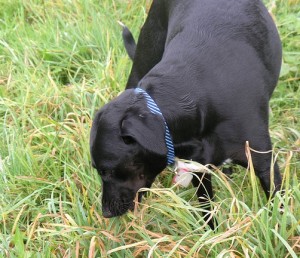Making your own dog food is more economical and easier than you might think. The alternative title for this article could also be “how to stop your dog from eating his own poop,” but I might not get as many readers because of the gross out factor.
Actually, I can’t be certain this will work, but of all the dog owners I’ve queried on this and the subject of dogs eating inappropriate things (including non-food items), they share one thing in common: They only feed their dogs dry kibble.
Think about it. Here is this wonderful creature with this amazing sense of smell (which goes along way toward tasting food as well), with the ability to sniff out mere traces of molecules, as studies have shown, and we are feeding it the equivalent of cardboard with flavoring and a large dose of yuck (read about animal digest, a common ingredient in many dog foods).
The same thing, day after day. Wouldn’t you grow tired of that?
And with this incredible nose, dogs intrinsically can determine the most nutritious item in front of them and will choose to eat it over any other item. Put a steak in front of them and a liver and they will eat the liver because it’s way more nutritious.
Sometimes I will test out a new brand of chip on my dog and if he won’t eat it I won’t either. Likely there is not enough nutrition to make it worthwhile. He can be choosey because he is well fed and not starving and desperate for nutrition.
 You know that if a dog is constantly seeking out nutrition in poop, he is likely in need of a diet re-evaluation. If you ask a vet or a pet-food expert, they may steer you into buying more products designed to curb your dog’s tendencies, but then you are just shelling out more money on a crap-shoot (ha-ha) and not really addressing the underlying issue.
You know that if a dog is constantly seeking out nutrition in poop, he is likely in need of a diet re-evaluation. If you ask a vet or a pet-food expert, they may steer you into buying more products designed to curb your dog’s tendencies, but then you are just shelling out more money on a crap-shoot (ha-ha) and not really addressing the underlying issue.
Now I’m not claiming to be a nutrition expert, but am simply laying out one theory that so far has borne good results.
My conclusion is this: dogs have evolved eating our scraps for more than 5,000 years, and so that is actually what they are used to eating and as long as what we are eating is healthy, is perfectly fine to share it with them.
I don’t buy the hooey about “people” food being bad for dogs. There is no such thing. There is high-quality and low-quality food and stuff that is barely recognizable as food.
I don’t think we have to wind the clock back further to the “wolf days” before the dog was domesticated (what proponents of the raw diet believe), but I do believe that we could have fewer vet bills and behavioral issues in the long run if we just gave our dogs a bit more “real” food to eat.
By “real” food I mean higher quality food and a variety of food items, excepting a few no-no foods like raisins, raw onions and chocolate.
Now for the fun part…what I actually feed my dogs and how I came to cooking it myself.
It was during the first major dog food scare over ingredients coming from China that were causing organ failure in dogs that I started to contemplate making my own dog food. I bought a couple of books on dog nutrition and consulted my vet.
My vet was against it as she didn’t think it would be possible to get the critical calcium/phosphorus balance in the diet (she insisted I include organ meat, which I do). During this time, I was feeding my young dog a combination of canned and dry food, and purchasing dried chicken and liver treats for snacks.
 I researched the dog food brands and tried to find a high quality brand, but it seemed like most of them got their ingredients from China, and it was hard for them to trace the ingredient origins much further. This did not sit well with me, and at every meal I watched my dog’s reaction to the food.
I researched the dog food brands and tried to find a high quality brand, but it seemed like most of them got their ingredients from China, and it was hard for them to trace the ingredient origins much further. This did not sit well with me, and at every meal I watched my dog’s reaction to the food.
Usually the first day he was enthusiastic enough, but as the days progressed he was less and less interested, and by day 4 or 5, didn’t want to eat it. I wonder if he got a bad feeling from it.
Rather than try to coax him to eat something that was likely not so great, I would switch to a brand I thought might be better, but the same thing happened over and over. Finally, a light went on in my head and I decided that if I purchased meat when it went on sale, I might be able to actually make the wet food myself for cheaper that it cost me to buy it in the cans.
I buried myself in my doggie nutrition books and also looked for recipes online. Finally I settled on one that seemed to address most of the recommendations:
Amanda’s Homemade Dog Food
This recipe feeds my two standard poodles for about 12 days, and makes about 18 lbs of food, which we put in 24 oz containers and freeze. Each container feeds both dogs for one day.
- 10-12 lbs muscle meat
- 2-3 lbs organ meat
- 12 cups cooked rice (4 cups dry)
- 6 medium carrots
- 4 medium yams
- ¼ cup seaweed
- ¼ cup crushed eggshells or bonemeal
To cook the meat, I purchased a 5 gallon tamale pot from Target for $19. We throw in everything together except the seaweed and eggshells, which can be added after the other ingredients are cooked. Also, we pre-steam the carrots since they take so long to soften.
It’s important for all ingredients to be soft and cooked so they will get down the chute of the grinder without clogging it up.
Cooking will usually take a couple of hours and it only needs minimal stirring after it’s been brought to a boil and covered and put on low. During this time you can relax or set up the grinder and containers for the next part.
We got our first grinder from Bed Bath and Beyond (a Cuisinart), but it kept breaking so we returned it. I researched grinders on Amazon.com and ended up getting one that was the best reviewed and haven’t been sorry. It’s worth spending about $200 on it and will save you many headaches later.
Once all the ingredients are cooked and removed from heat, get out a couple of large mixing bowls to capture the ground mixture and start putting your items down the chute and watch them come out as dog food on the other end!
 This is not a quick process but more of a zen-like one. You must do it at a fairly slow pace so things don’t get jammed up. It should take about 30 minutes. After you have finished you can mix in the seaweed and crushed eggshells (or bonemeal). Voila! Dog food!
This is not a quick process but more of a zen-like one. You must do it at a fairly slow pace so things don’t get jammed up. It should take about 30 minutes. After you have finished you can mix in the seaweed and crushed eggshells (or bonemeal). Voila! Dog food!
Line up your containers and start filling them with a big spoon. I try to make sure there are no air pockets as this will allow them to keep better when they are frozen. When you are done you should have about 12+ containers. Keep one fresh one in the fridge and put the rest in the freezer.
For our dogs, we simply give them each a quarter serving per meal, and take out a new container every day to thaw (takes about a half day). My dog is now a happy camper and never gets tired of his food.
I also “free” feed him dry kibble, meaning it’s always available if he feels hungry. He often nibbles on it after his meal if he’s still hungry. You might think he’d get over weight, but he doesn’t. People always remark about the ideal weight of my dogs.
After this became a routine, there was one thing left for me to do: make my own dog treats. This may sound like a lot of work but it’s actually quite easy if you have the right equipment. I purchased a dehydrator from Amazon and it’s been a wonderful addition to my kitchen.
For treats, all I do is purchase some chicken or beef, slice it up, and put it on the dehydrator trays and leave it overnight on the dehydrator’s beef jerky setting. When I get up the next morning, “Voila!” fresh dog treats.
We also make spiced beef jerky for ourselves, along with wonderful dried fruit. The dehydrator can also be used for rising bread dough and many other things. It continues to be a beneficial purchase.
So in conclusion I can say that it’s really not that hard to do if you make it a routine, and you will feel better about knowing a little bit more about what is in your dog’s food.
And your dog, when he knows he’s going to get a satisfying nutritious meal twice a day and high quality snacks in-between, he’s not going to desperately scan the countertops every chance he gets, so see what kind of scrap he can steal.
I also make sure to give my dogs tidbits of what I’m eating so they don’t ever have the urge to sneak food. So if your dog is having issues, I definitely recommend trying some home-cooked meals, or at the very least, some canned food if all you are feeding is dry.
Both you, and your canine companion, will rest easier.


